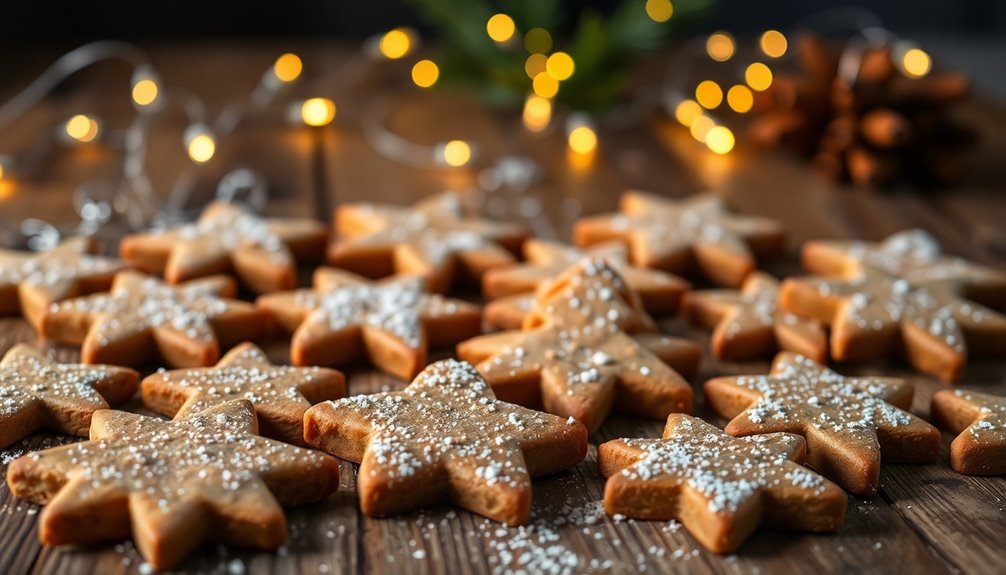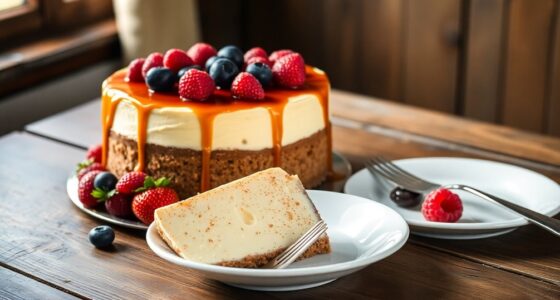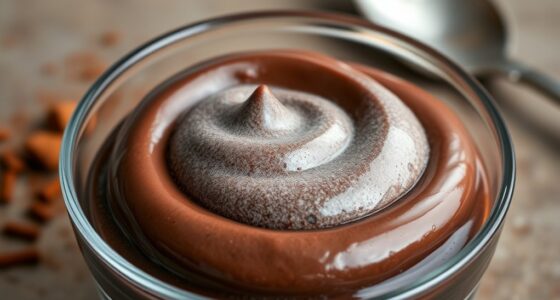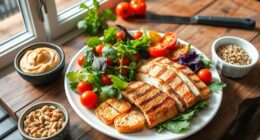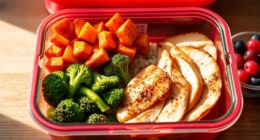Gingerbread buckwheat cookies are a festive twist on the classic treat. They blend the rich flavors of molasses and spices with gluten-free buckwheat flour for a delightful, nutritious option. You'll love the perfect combination of a chewy center and crisp edges. These cookies are great for holiday gatherings or as a quick snack with tea. Plus, you can easily adapt the recipe by adding nuts or dried fruits for extra flavor and texture. Discover more tips and variations to make them uniquely yours!
History
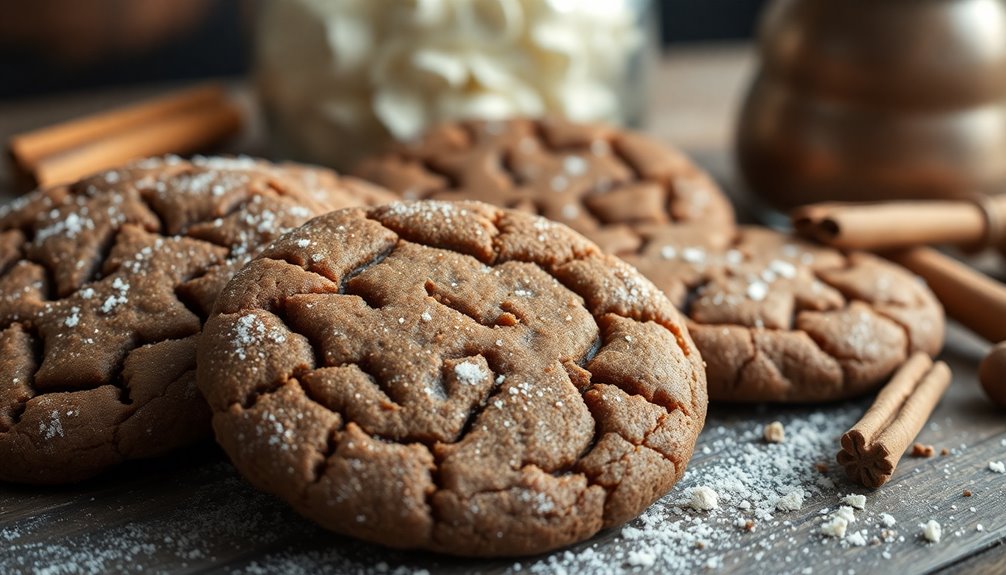
Gingerbread cookies have a rich history that dates back to ancient Greece and Rome, where honey and spices were combined in various baked goods.
Over the centuries, these cookies evolved significantly, particularly in Europe during the Middle Ages. By then, they'd become popular festival treats in Germany and England, often shaped into festive figures.
Fast forward to the 19th century, and gingerbread became synonymous with the holiday season, with recipes adapting to include molasses and spices, resulting in the soft, chewy delights we cherish today.
In the 19th century, gingerbread transformed into a holiday favorite, blending molasses and spices into the soft, chewy treats we love today.
Nowadays, the use of buckwheat flour in gluten-free variations reflects a growing trend in baking, allowing everyone to enjoy the rich flavors and textures of gingerbread cookies, regardless of dietary restrictions.
Recipe
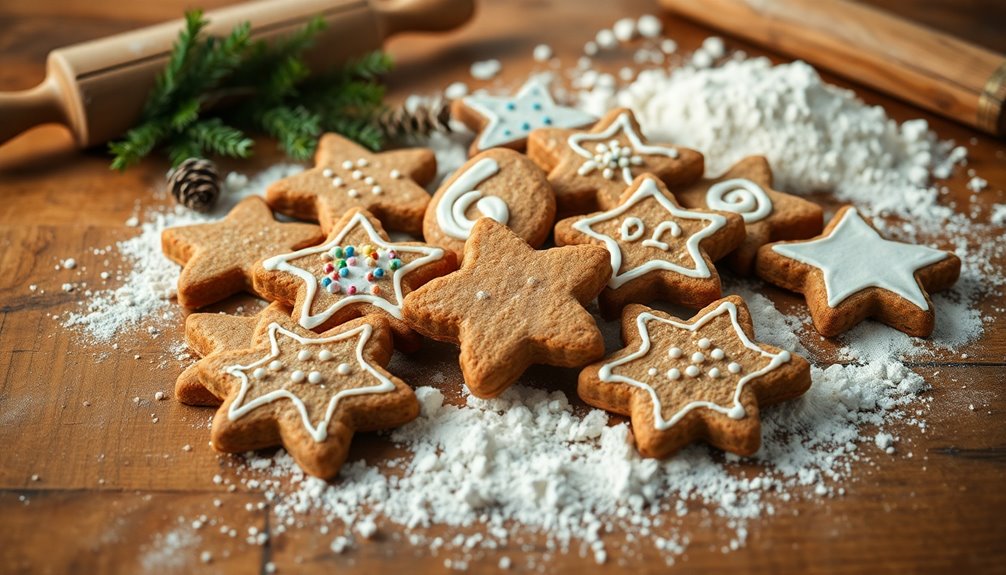
To create the ideal texture, the dough is made by blending dry ingredients with wet ingredients, resulting in a rich and chewy cookie. Rolling the dough in granulated sugar before baking gives the cookies a sweet and crisp exterior, making them a delightful addition to any holiday gathering.
These cookies are best enjoyed slightly soft in the center, with a satisfying crunch around the edges.
Ingredients:
- 2 cups buckwheat flour
- 1 teaspoon ground ginger
- 1 teaspoon cinnamon
- 1/2 teaspoon ground cloves
- 1/2 teaspoon baking soda
- 1/2 teaspoon salt
- 1/2 cup unsalted butter, softened
- 1/2 cup molasses
- 1 egg
- 1 cup granulated sugar (for rolling)
Cooking Instructions:
Begin by preheating your oven to 350°F (175°C). In a large mixing bowl, whisk together the buckwheat flour, spices, baking soda, and salt until well combined.
In another bowl, cream the softened butter and molasses together. Add the egg and mix until smooth. Gradually incorporate the dry ingredients into the wet mixture, stirring until a dough forms.
Once the dough is ready, scoop out tablespoon-sized portions, roll them into balls, and then roll each ball in granulated sugar. Place the coated dough balls on a parchment-lined baking sheet, spacing them about 2 inches apart.
Bake for 8-12 minutes, or until the edges are crisp and the centers are slightly soft. Allow the cookies to cool on the baking sheet for a few minutes before transferring them to a wire rack to cool completely.
Extra Tips:
For an added touch, you can experiment with different spices or even add a pinch of nutmeg for extra warmth.
Make sure your butter is softened to room temperature for easier mixing, and consider chilling the dough for about 30 minutes before rolling it in sugar to help maintain the cookie shape during baking.
Store the cooled cookies in an airtight container to keep them fresh, and they can also be frozen for longer enjoyment!
Cooking Steps
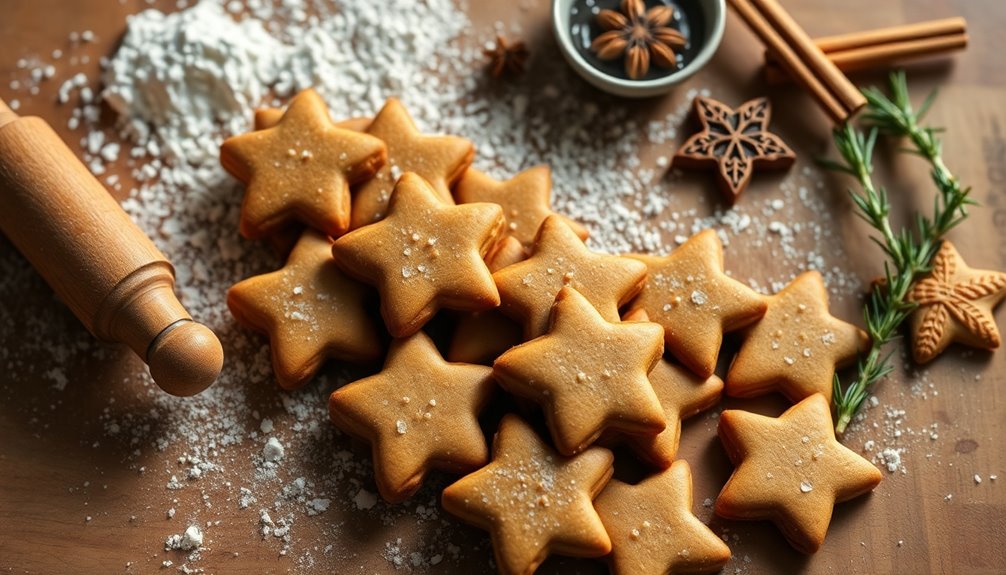
Let's get cooking! Start by gathering all your ingredients, then combine the molasses and eggs for a rich flavor.
Sift together the dry ingredients and spices to set the stage for delicious gingerbread buckwheat cookies.
Step 1. Gather All Necessary Ingredients
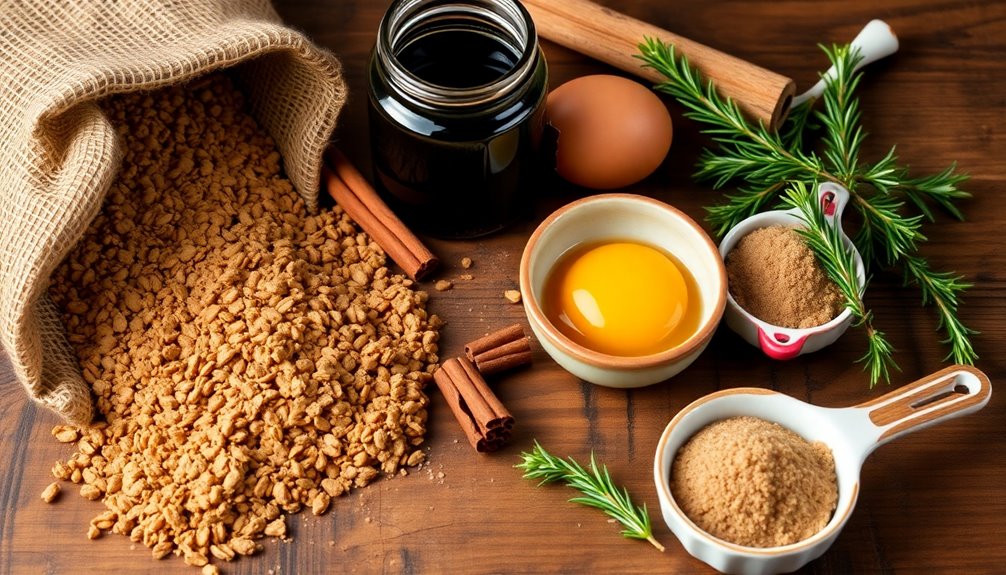
Before you start baking these delicious cookies, it's essential to gather all the necessary ingredients.
You'll need 2 1/4 cups of buckwheat flour, 2 teaspoons of baking soda, and spices like ground ginger, cinnamon, and cloves.
For the wet mixture, make sure you have coconut oil or butter, along with your choice of sugars, like sucanat or coconut sugar, an egg, and molasses.
Prepare a mixing bowl for the dry ingredients and a separate bowl for the wet ingredients.
Once combined, use an ice cream scoop to form dough balls, ensuring each is about 1-inch in diameter.
Finally, roll the dough balls in granulated sugar before placing them on an ungreased cookie sheet for baking.
Happy baking!
Step 2. Combine Molasses and Eggs
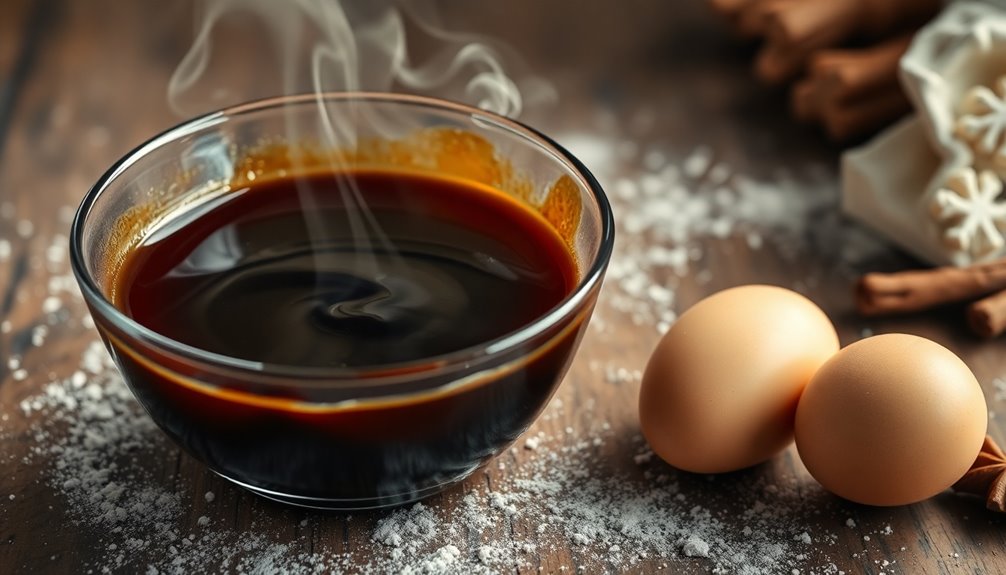
Start by measuring the molasses, making sure it's packed for the best sweetness and moisture.
Next, crack the eggs into a separate bowl to avoid any shell fragments, and beat them lightly until they're uniform. Gradually mix the beaten eggs into the molasses, stirring continuously to create a smooth, cohesive wet mixture.
This combination will help ensure your cookie dough has the right texture. Using room temperature eggs makes blending easier, so consider taking that extra step for better results.
You can adjust the amount of molasses based on your sweetness preference, but remember, it also plays a crucial role in the cookie's moisture and chewy texture.
This blend of wet ingredients sets the stage for delicious gingerbread buckwheat cookies.
Step 3. Sift Together Dry Ingredients

Sift together the buckwheat flour, baking soda, ginger, cinnamon, and salt in a large mixing bowl. This step is crucial for aerating the dry ingredients, which helps create a lighter and fluffier cookie texture.
Sifting also ensures that the baking soda and spices are evenly distributed, promoting uniform flavor and leavening throughout the cookie batter. As you sift, you'll break up any clumps that may form in the buckwheat flour, resulting in a smoother mixture.
Additionally, this process removes any impurities or larger particles, contributing to a finer quality in your final baked product. With the dry ingredients ready, you'll be set for the next step in creating delicious gingerbread buckwheat cookies.
Step 4. Incorporate Spices and Mix

To create a flavorful base for your gingerbread buckwheat cookies, gradually incorporate the spices into the flour mixture.
Start by sifting together the buckwheat flour, baking soda, ground ginger, cinnamon, and cloves. Use about 1 teaspoon of ground ginger, 1 teaspoon of ground cinnamon, and 1/2 teaspoon of ground cloves for a balanced flavor profile.
In a separate bowl, mix the wet ingredients, such as melted butter or coconut oil, with sugars, eggs, and molasses until smooth.
Next, combine the wet and dry mixtures, beating until just combined to prevent overmixing. This ensures your dough maintains a great texture.
Once formed into balls, consider rolling them in granulated sugar for an extra crunchy exterior before baking.
Step 5. Chill Dough for 30 Minutes
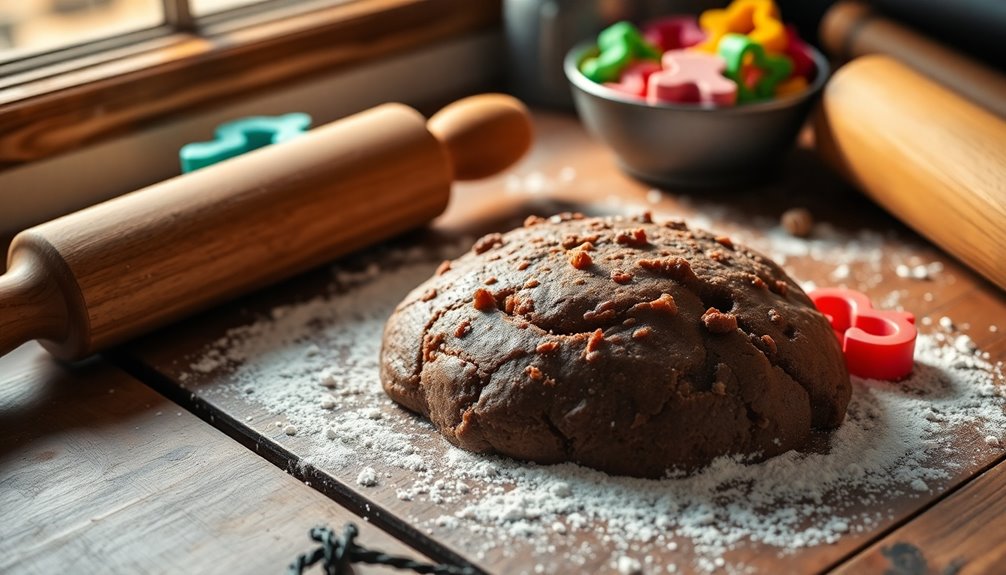
Chilling the dough for 30 minutes is crucial for achieving the perfect gingerbread buckwheat cookies. This step helps solidify the fats, resulting in a firmer, more manageable dough that holds its shape during baking.
When you chill the dough, it minimizes spreading, ensuring your cookies maintain their desired thickness and texture. Plus, refrigerating the dough allows the flavors to meld together, enhancing the overall taste of your cookies.
A chilled dough is also less sticky, making it easier for you to form balls or shapes without a mess. Ultimately, this chilling process improves the final cookie's texture, giving you chewier, more satisfying bites that everyone will love.
Final Thoughts
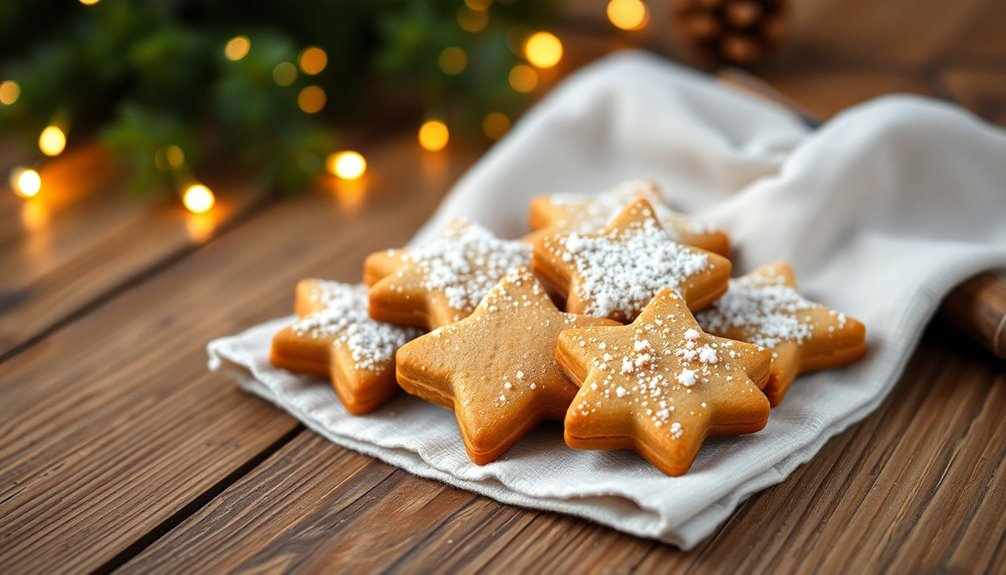
While you might be new to baking with buckwheat, gingerbread buckwheat cookies offer a delicious and healthy twist on a classic favorite. By using buckwheat flour, you're tapping into the benefits of whole grains, which can improve blood sugar control and lower cholesterol levels. The combination of spices and salt, along with sweeteners like maple syrup or molasses, creates that traditional gingerbread flavor you crave. Rolling the dough in turbinado sugar before baking adds a delightful crunch and sweetness. Additionally, incorporating chia seeds' health benefits into your diet can enhance your weight loss journey. Eating these cookies can also contribute to increased energy levels, making them a great option for a quick snack. Moreover, the use of whole grains in your baking can promote better digestive health. Bake these cookies at 350°F for 8 to 12 minutes, achieving a perfect chewy center and crisp edges. As a gluten-free treat, they might take some getting used to, but they're sure to become a seasonal favorite in your kitchen.
Frequently Asked Questions
Are Gingerbread Buckwheat Cookies Gluten-Free?
When you think about gluten-free options, it's essential to check the ingredients.
If you're using buckwheat flour, you're in luck! Buckwheat isn't a wheat at all; it's a seed, making it naturally gluten-free.
So, if your recipe is solely composed of buckwheat flour and other gluten-free ingredients, you've got a safe treat.
Just ensure there's no cross-contamination with gluten-containing products, and you can enjoy them worry-free!
How Long Do These Cookies Last?
When it comes to cookies, their shelf life can vary based on ingredients and storage.
Generally, if you store them in an airtight container at room temperature, they'll last about a week. If you refrigerate them, they can stay fresh for up to two weeks.
For longer storage, consider freezing them; they'll maintain quality for about three months. Just make sure to let them cool completely before sealing them away.
Can I Substitute Buckwheat Flour With Regular Flour?
Did you know that around 30% of people have gluten sensitivity? If you're one of them, substituting buckwheat flour with regular flour mightn't be the best choice.
Buckwheat is gluten-free and has a unique flavor that regular flour can't replicate.
However, if you don't have gluten issues, you can substitute it, but expect a different texture and taste.
Adjust your liquids, as regular flour absorbs moisture differently than buckwheat.
What Can I Use Instead of Molasses?
If you need a substitute for molasses, you've got a few options.
You can use honey or maple syrup for a sweeter flavor, but they're thinner, so adjust your liquid ingredients accordingly.
Brown sugar mixed with a bit of water can mimic molasses' thickness and flavor as well.
For a deeper taste, try using dark corn syrup, which offers a similar consistency without altering your recipe too much.
Are These Cookies Suitable for Vegan Diets?
When it comes to vegan diets, you might think it's a tough cookie to crack.
However, many cookie recipes can easily be adjusted to fit your needs. If the recipe uses eggs or dairy, you can substitute those with flax eggs or plant-based milk.
Just make sure to check all the ingredients; some sweeteners or flavorings mightn't be vegan.
With a few tweaks, you can enjoy a delightful vegan treat!
